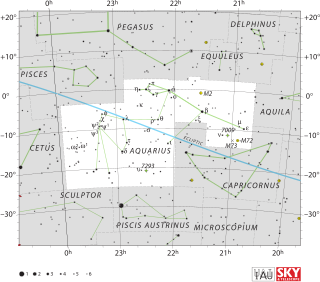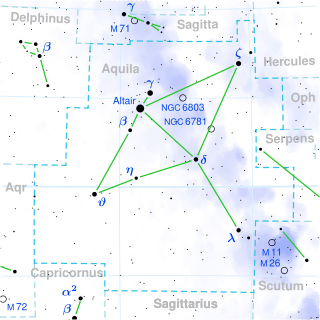Related Research Articles

Delta Aquarii, officially named Skat, is the third-brightest star in the constellation of Aquarius. The apparent visual magnitude is 3.3, which can be seen with the naked eye. The distance to this star is about 113 light-years based upon parallax measurements, and it has a close companion.

Gamma Aquarii, or γ Aquarii, is a suspected binary star system in the constellation of Aquarius. It has an apparent visual magnitude of 3.849, making it one of the brighter members of the constellation. Based upon parallax measurements taken during the Hipparcos mission, this star is located at a distance of approximately 164 light-years from the Sun. It is drifting closer to the Sun with a radial velocity of −16 km/s. In 1998, Olin J. Eggen included this star as a candidate member of the Hyades Supercluster.

Xi Aquarii is a binary star system in the equatorial constellation of Aquarius. It is visible to the naked eye with an apparent visual magnitude of 4.7. Based upon parallax measurements made during the Hipparcos mission, this system lies at a distance of around 179 light-years from the Sun.

Rho Virginis is the Bayer designation for a star in the constellation Virgo. It has an apparent visual magnitude of +4.9, making it a challenge to view with the naked eye from an urban area. The distance to this star has been measured directly using the parallax method, which places it 118.3 light-years away with a margin of error of about a light year.

91 Aquarii is the Flamsteed designation for a triple star system in the equatorial constellation of Aquarius. It also bears the Bayer designation Psi1 Aquarii. It is visible to the naked eye with an apparent visual magnitude of +4.248. Parallax measurements yield an estimated distance of around 150 light-years from Earth. An extrasolar planet is known to orbit the main star.

Psi3 Aquarii, Latinized from ψ3 Aquarii, is the Bayer designation for a visual binary star system in the constellation of Aquarius. It has an apparent visual magnitude of 4.98, which is bright enough to be seen with the naked eye. Parallax measurements give a distance estimate of roughly 262 light-years.

101 Aquarii is a star in the equatorial constellation of Aquarius. 101 Aquarii is the Flamsteed designation, although it also bears the Bayer designation b3 Aquarii. The combined apparent visual magnitude of the pair is 4.71, which is bright enough to be seen with the naked eye from the suburbs. The distance of this star from Earth is estimated as 290 light-years based upon parallax measurements.
94 Aquarii is a triple star system in the equatorial constellation of Aquarius. 94 Aquarii is the Flamsteed designation. The brightest member has an apparent visual magnitude of 5.19, making it visible to the naked eye. The parallax measured by the Gaia spacecraft yields a distance estimate of around 73 light-years from Earth.
107 Aquarii is a double star in the equatorial constellation of Aquarius. 107 Aquarii is the Flamsteed designation, although it also bears the Bayer designation i2 Aquarii. The pair have an angular separation of 6.787 arcseconds. They have a combined apparent visual magnitude of +5.305, with individual magnitudes of 5.72 and 6.72. The annual parallax shift measured for the two components is 16.1 mas and 20.0 mas respectively, although with significant statistical margins of error and flags for potential unreliability of both values. This indicates the system may be at a distance of 160–200 light-years from Earth.
42 Aquarii is a single star located 447 light years away from the Sun in the zodiac constellation of Aquarius. 42 Aquarii is its Flamsteed designation. It is visible to the naked eye as a faint, orange-hued star with an apparent visual magnitude of 5.34. This object is moving further from the Sun with a heliocentric radial velocity of around +13 km/s.
18 Aquarii is a single, yellow-white hued star in the equatorial constellation of Aquarius. The designation is from the catalogue of English astronomer John Flamsteed, first published in 1712. The star is faintly visible to the naked eye with an apparent visual magnitude of 5.49 and is located about 154 light-years from Earth.
51 Aquarii is a binary star system located around 410 light years away from the Sun in the equatorial constellation of Aquarius. 51 Aquarii is its Flamsteed designation. It is visible to the naked eye as a dim, yellow-white hued star with a combined apparent visual magnitude of 5.78. The system is moving further from the Earth with a heliocentric radial velocity of +6 km/s.
15 Aquarii, abbreviated 15 Aqr, is a single, blue-white star in the zodiac constellation of Aquarius. 15 Aquarii is the Flamsteed designation. It is a dim star that is just visible to the naked eye under good viewing conditions, having an apparent visual magnitude of 5.83. Based upon an annual parallax shift of 4.6 mas, it is located around 710 light years away. At that distance, the visual magnitude is diminished by an extinction of 0.18 due to interstellar dust. It is moving closer to the Earth with a heliocentric radial velocity of −9 km/s. Relative to its neighbors, 15 Aqr has a peculiar velocity of 28.7+2.9
−3.1 km/s and may be a runaway star.
16 Aquarii, abbreviated 16 Aqr, is a star in the constellation of Aquarius. 16 Aquarii is the Flamsteed designation. It is a faint star, just visible to the naked eye, with an apparent visual magnitude of 5.869. Based upon an annual parallax shift of 9.5 mas, it is located about 342 light years away. It is moving closer to the Earth with a heliocentric radial velocity of −6 km/s, and is predicted to come within 220 light-years in 6.8 million years.
60 Aquarii is a star located 375 light years away from the Sun in the equatorial constellation of Aquarius. 60 Aquarii is its Flamsteed designation. It is visible to the naked eye as a dim, yellow-hued star with an apparent visual magnitude of 5.89. The star is moving closer to the Earth with a heliocentric radial velocity of –8 km/s.

35 Aquilae is a star in the equatorial constellation of Aquila. 35 Aquilae is its Flamsteed designation though it also bears the Bayer designation c Aquilae. The apparent visual magnitude of this star is 5.8, which means it is a faint star but visible to the naked eye from dark suburban or rural skies. It has an annual parallax shift of 16.34 mas that is caused by the Earth's orbit around the Sun. This yields a distance estimate of 200 light-years, give or take a 4 light-year margin of error. At this distance, the visual magnitude is diminished by 0.26 from extinction caused by interstellar gas and dust.

Omega1 Aquarii, Latinized from ω1 Aquarii, is the Bayer designation for a single star in the equatorial constellation of Aquarius. With an apparent visual magnitude of 4.96, this star is faintly visible to the naked eye from the suburbs. The distance to this star can be estimated from the parallax as approximately 138 light-years.

Omega2 Aquarii, Latinised from ω2 Aquarii, is the Bayer designation for a triple star system in the equatorial constellation of Aquarius. It can be seen with the naked eye, having an apparent visual magnitude of 4.49. The approximate distance to this star, 149 light-years, is known from parallax measurements taken during the Hipparcos mission.
HD 16955, also known as HR 803, is a double or multiple star. With an apparent visual magnitude of 6.376, is lies at or below the nominal limit for visibility with a typical naked eye. The measured annual parallax shift is 9.59 milliarcseconds, which yields an estimated distance of around 340 light years. The star is moving closer to the Sun with a heliocentric radial velocity of around -10 km/s.
36 Serpentis is a binary star system in the equatorial constellation of Serpens. It has the Bayer designation b Serpentis, while 36 Serpentis is the Flamsteed designation. The system is visible to the naked eye as a dim, white-hued point of light with a combined apparent visual magnitude of 5.09. It is located 162 light years away from the Sun based on parallax, and is moving closer with a radial velocity of −8 km/s.
References
- 1 2 3 4 5 6 van Leeuwen, F. (November 2007), "Validation of the new Hipparcos reduction", Astronomy and Astrophysics, 474 (2): 653–664, arXiv: 0708.1752 , Bibcode:2007A&A...474..653V, doi:10.1051/0004-6361:20078357, S2CID 18759600.
- 1 2 3 4 Nicolet, B. (1978), "Photoelectric photometric Catalogue of homogeneous measurements in the UBV System", Astronomy and Astrophysics Supplement Series, 34: 1–49, Bibcode:1978A&AS...34....1N.
- 1 2 3 Eggleton, P. P.; Tokovinin, A. A. (September 2008), "A catalogue of multiplicity among bright stellar systems", Monthly Notices of the Royal Astronomical Society , 389 (2): 869–879, arXiv: 0806.2878 , Bibcode:2008MNRAS.389..869E, doi: 10.1111/j.1365-2966.2008.13596.x , S2CID 14878976.
- 1 2 Christy, James W.; Walker, R. L. Jr. (October 1969), "MK Classification of 142 Visual Binaries", Publications of the Astronomical Society of the Pacific, 81 (482): 643, Bibcode:1969PASP...81..643C, doi: 10.1086/128831
- ↑ Wilson, Ralph Elmer (1953). "General Catalogue of Stellar Radial Velocities". Carnegie Institute Washington D.C. Publication. Washington: Carnegie Institution of Washington. Bibcode:1953GCRV..C......0W.
- ↑ Anonymous (1999), "New orbits", International Astronomical Union Commission 26 (Double Stars), 139 (Information Circular No. 139): 1–2, Bibcode:1999IAUDS.139....1.
- ↑ Royer, F.; Zorec, J.; Gómez, A. E. (February 2007), "Rotational velocities of A-type stars. III. Velocity distributions", Astronomy and Astrophysics, 463 (2): 671–682, arXiv: astro-ph/0610785 , Bibcode:2007A&A...463..671R, doi:10.1051/0004-6361:20065224, S2CID 18475298.
- ↑ "* 97 Aqr". SIMBAD . Centre de données astronomiques de Strasbourg . Retrieved 2012-07-17.
- ↑ Gerbaldi, M.; Faraggiana, R.; Lai, O. (December 2003), "The heterogeneous class of lambda Bootis stars", Astronomy and Astrophysics, 412 (2): 447–464, Bibcode:2003A&A...412..447G, doi: 10.1051/0004-6361:20031472 .